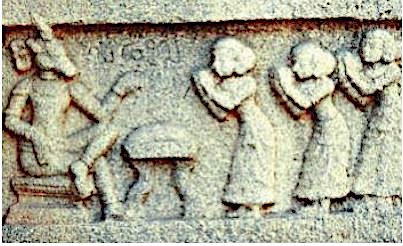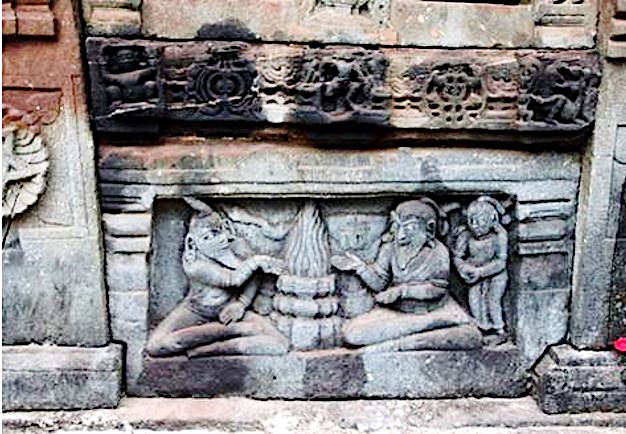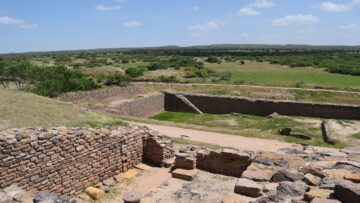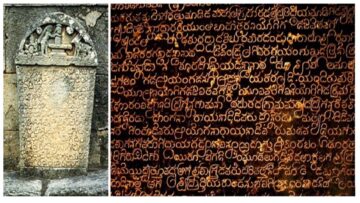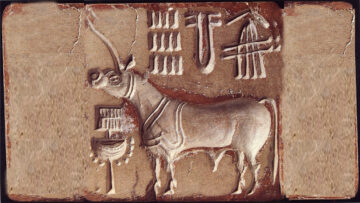A king was revered in ancient times as “Nara Devata.” The dynastic hero of Suryavamsha, Shri Rama of the epic Ramayana, was born with divine intervention to be born with superhuman capacities to destroy evil and hence was revered as an incarnation of Vishnu. The Valmiki Ramayana mentions that the three queens of King Dasharatha – Kausalya, Sumitra, and Kaikeyi, faced the disheartening plight of barren wombs and could not produce children naturally. The queens’ infertility was also a matter of great concern for the king as children were needed to decide an accomplished future heir of Ayodhya. The king, Dasharatha, aware of the importance of progeny in determining a future heir, sought divine intervention upon realizing the natural impediment to his queens’ fertility. Seeking counsel from the esteemed sage Vasishtha, Dasharatha was advised to perform the Putrakameshti Yajna, a fire ritual believed to bestow the blessing of children upon its practitioners. King Dasharatha desired and decided to perform the Putrakameshti Yajna (a kaamana-karma ritual), set to organize the said fire ritual. This ceremonial term translates lucidly to ‘ signifying that those who undertake this ritual are destined to bear children, provided the ceremony is executed systematically.
Sage Vasishtha recommended the accomplished sage Rishyasringa, who was well-versed in the Vedas, to oversee the grand ceremony. Among the Vedas, only the Yajurveda provided specific guidelines for successfully executing the Putrakameshti Yajna.
Rishyashringa
Rishyashringa, a revered sage, is best known for his role in the Ramayana, one of the major epics of ancient Bharata. According to the Ramayana, Rishyashringa was a young and powerful sage raised in isolation by his father, Vibhandaka, deep in the forest. Due to his secluded upbringing, Rishyashringa was unaware of the outside world and had not seen any women. Rishyashringa had mastered all four Vedas and had acquired special Siddi of invoking gods in the Yajna through special chanting of spell mantras. King Dasharatha invited Rishyashringa to his kingdom to conduct the Putrakamesti Yajna.
Putrakameshti
Putrakameshti was a Yajna celebrated for some days to appease Agni, the God of Fire, who was propitiated to solve the fertility issue. According to Yajurveda, one who desires male progeny can perform this ritual. It runs for four days, involving elaborate preparations like the consecration of the sacrificial ground (Yajna shala), arranging for the purification of priests, establishing sacred fire altars, fetching grains, ghee, varieties of fuel sticks such as Samidhi sticks and logs of wood to invoke Agni or maintain the fire burning, and so on. The Pavamanastotras of increasing order, a 24-fold splendor of prosperity, were chanted along with offering sacrificial cakes. The outcome of this Yajna was the performer would get sons like a good Hotri, a good Udgatri, a good Adhvaryu, and a good counselor. The ceremony was meticulously planned to align with the queens’ active ovulation, marking a crucial juncture in determining the kingdom’s future.
(Figure 1: Sage Rishyashringa conducting the Putrakamesti Yajna and the three queens.
Sculpture on the outer wall of Ramachandra temple in Hampi, Karnataka, India)
(Figure 2: Sage Rishyashringa with a horn on his head and Dasharatha performing the Putrakameshti yajna)
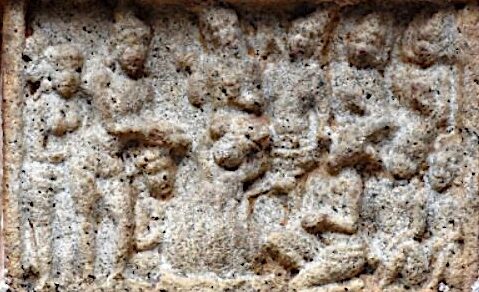
(Figure 3: Agni emerging out of the fire holding a vessel with Payasa, Rishyasringa with deer’s face. From the miniature panels at Nageswara temple, Kumbhakonam).
The depiction of Putrakameshti Yajna is seen in many temples in India. Rishyashringa is depicted in temple sculptures with a deer’s face or deer’s horn on the head and a sage-like appearance. The depiction is likely a reference to his upbringing. According to the story, sage Vibhandaka’s deep penance was disturbed by the Apsara Urvashi, and in due course, Rishyashringa was born with the horn of a deer on the head. This unusual growth made the mother and Apsara Urvashi abandon the child and move to her abode of heaven. Rishyashringa (rishi with shringa, meaning horn) was raised in the forest by the father, Vibhandaka, without any human contact, and his only companion was a male deer. The close association with the deer led to the unique representation of Rishyashringa with a deer’s face in some artistic depictions. This iconography symbolizes the identification of the great sage and a priest. It’s a distinctive visual element that emphasizes the unusual circumstances of his upbringing and his role in the Ramayana narrative.
The outcome of the Putrakameshti Yajna in Ramayana
Rama’s birth, though biological, is embedded in a compelling tale that diverges from conventional narratives. The underlying factor in this saga is the exceptional fire ritual Putrakameshti Yajna. Rishyashringa conducted the Putrakameshti, during which the Devas discussed the atrocities committed by Ravana. After responding to the Devas’ concerns, Bhagavan Mahavishnu assured them he would incarnate as four human beings to address the menace of Ravana, his son, Lavanasura, and the troublesome Gandharvas.
To facilitate his incarnation, the essence of Bhagavan had to enter the wombs of the queens of Dasharatha. In adherence to Vedic procedures, Mahavishnu prepared a special herbal payasam, which would result in their pregnancies when consumed by the queens.
Ascetics chanting hymns created an atmosphere of anticipation for the king, Dasharatha, and queens. Upon the ritual’s culmination, deity Agni emerged in a personified form, smiling upon the royal assembly and offering a bowl of holy payasam wrapped in banana leaves. He declared that consuming this herbal preparation would result in the queens’ pregnancies, heralding the imminent arrival of children in the royal palace. Dasharatha, blessed by Agni, was overjoyed, received the divine payasam, placed it on his head respectfully, and distributed it among the three queens. The distribution of the payasam was not Dasharatha’s discretion but followed the prescribed Vedic rules.
The hierarchical protocol for consuming the prasada was meticulously followed. The first queen received half, the second queen less than the first, and the third queen less than the second. Even after providing for Kaikeyi, one-eighth of the remaining payasam was given to the second queen, Sumitra. True to Agni’s words, all three queens became pregnant, giving birth to the Ayodhya princes – Rama, Lakshman, Bharata, and Shatrughna. Sumitra gave birth to two sons, Lakshmana and Shatrughna, by consuming her one-fourth and one-eighth portions separately.
The children born after the Putrakameshti Yajna were compared to the four Vedic priests, the Maharitvijas, in their personalities. Rama was the chief hero with all the good qualities of a Rigvedic priest. Lakshmana was like the Yajurveda priest, always on the move and with work execution. Bharata can be compared to the Samaveda priest Udgatri, reciting chants drawn from Rigveda. Shatrughna-the, the fourth son, was like an Atharvaveda priest Brahman, who cared for many things.
This systematic distribution resulted in the birth of four sons to Dasharatha, each representing a fraction of the divine essence. Rama, being half of Mahavishnu, Lakshmana half of Rama, and Bharata and Shatrughna half of Lakshmana each, symbolizing the significance of the ritual in bringing about the desired outcome.
While various fire rituals are documented in history, the Putrakameshti Yajna in the Ramayana stands out as a pinnacle, symbolizing the birth of royal blood through the pure and transformative flames, destined to script heroic and divine histories, akin to the righteous and virtuous legacy of Rama.
Disclaimer: The opinions expressed in this article belong to the author. Indic Today is neither responsible nor liable for the accuracy, completeness, suitability, or validity of any information in the article.


